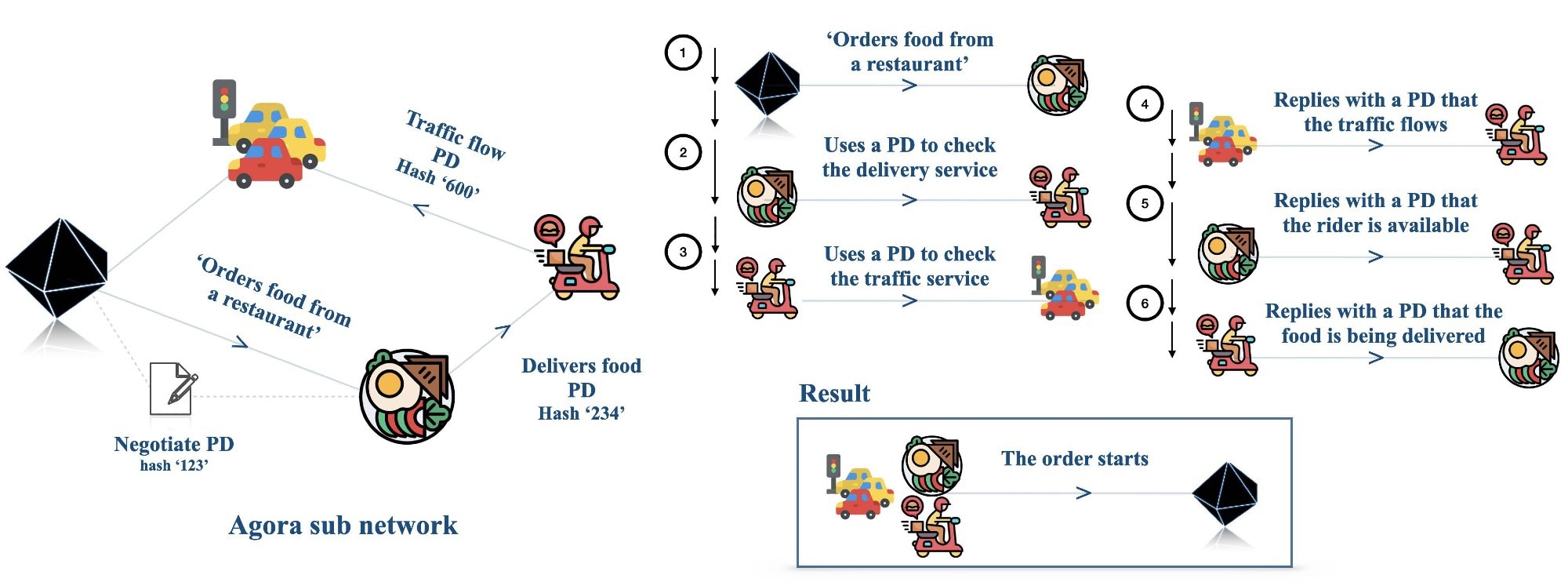This approach enabled scalability, complete decentralization, and minimal human involvement while handling frequent changes in interfaces and agents. In large Agora networks, self-organizing protocols emerged, achieving complex goals autonomously.
Related Work
Past work introduced Agora, a meta-protocol designed to solve the agent communication trilemma in large AI networks. It utilizes standard routines for frequent communication, natural language for rare exchanges, and LLM-written routines for intermediate tasks. A key challenge in scaling AI agent networks is balancing communication efficiency, versatility, and portability, often called the agent communication trilemma. Achieving these goals while maintaining scalability and decentralization without significant human intervention remains a complex problem.
Challenges in Agent Communication
The agent communication trilemma challenges the design of communication protocols for AI agent networks, as optimizing for versatility, efficiency, and portability is difficult. Versatility allows for handling diverse communication types, efficiency minimizes costs, and portability ensures ease of implementation across agents. These properties conflict, as improving one often compromises another. For instance, versatile systems like semantic web agents are complex to implement, while portable systems like the open banking platform are limited in scope.
As AI agents evolve, there is a trade-off between efficient communication, which minimizes costs, and versatile or portable systems. While versatile systems like LLMs can manage abstract, diverse exchanges, they have high computational costs, creating bottlenecks for scaling AI networks.
Additionally, natural language introduces ambiguity and error potential, making it less reliable than specialized application programming interfaces (APIs). Agora’s hybrid communication protocol leverages efficient systems like RESTful APIs, portable systems like RDF tuples, and versatile natural language exchanges to sidestep this challenge.
Agora: Adapting Communication Protocols
Agora is a meta-communication protocol designed to address the agent communication trilemma by adapting different communication methods depending on the context. It leverages the unique capabilities of LLMs, allowing agents to communicate efficiently and flexibly. A unique feature of Agora is its use of protocol documents (PDs), which are self-contained, implementation-agnostic descriptions of communication protocols. These PDs enable agents to interpret standardized exchanges autonomously.

Illustration of how in an Agora network with 100 agents (left; for clarity, only the relevant sub-network is displayed), an emergent protocol for food delivery emerges (right).
These PDs allow agents to handle standard communications with efficient routines, while LLMs can manage less frequent or complex interactions. The system is designed to prioritize efficiency for routine communications, using structured data when possible while reserving natural language for negotiations, error resolution, or unique queries. This structured approach minimizes human involvement and adapts to the addition or modification of agents within a network, creating a communication backbone that is both scalable and adaptable.
Agora operates as a layer-zero protocol, abstracting the underlying technologies and enabling agents to collaborate across diverse environments and tools. The system is independent of specific programming languages, databases, or tools, allowing agents with varied configurations to interact. PDs can reference other protocols, and routines can build upon prior negotiations, enabling agents to solve more complex tasks.
With its versatility and portability, Agora easily accommodates changes in network structure or agent capabilities, making it an ideal foundation for higher-level communication and collaboration. The ability to handle varying communication needs, from structured data to natural language, positions Agora as a powerful tool for developing sophisticated protocols and negotiation schemes in large networks of LLMs.
Scalable Autonomous Communication
Agora is demonstrated through two scenarios: one with two agents exchanging data and another with 100 agents to test scalability and autonomous coordination. The focus is on Agora's efficiency, versatility, portability, cost reduction, scalability, and emergent behaviors in LLM-powered networks.
Its design is based on minimality, decentralization, and backward compatibility, enabling agents to interact across diverse environments without central authority. Agora supports protocols like OpenAPI and JavaScript Object Notation (JSON)-Schema, offering flexibility in storing and accessing PDs, including decentralized options like IPFS.
Alice and Bob, AI agents communicating within the Agora network, created a protocol to exchange weather data in the first demo. Initially using natural language, the high cost of LLM invocation drove them to develop a JSON-based protocol. Once agreed upon, they implemented routines to handle communication tasks, reducing reliance on LLMs and lowering costs. This cost-efficient protocol demonstrates how Agora allows agents to develop shared standards for repeated exchanges.
Over time, Agora proves more efficient than natural language exchanges. In the larger 100-agent demo, Agora showcases scalability and self-organizing behavior by demonstrating how agents can develop shared protocols for complex tasks autonomously. The agents, including assistants and servers, handle diverse queries like hotel bookings and food orders. Through these interactions, agents autonomously achieve consensus and create a decentralized workflow for tasks, such as food delivery, even without prior knowledge of each other's roles.
Conclusion
To sum up, Agora, a meta-protocol, overcame the agent communication trilemma by combining natural language and structured protocols. Its scalability was demonstrated with a 100-agent network, reducing costs five-fold compared to natural language communication. The results highlighted the effectiveness of negotiation for creating efficient, decentralized networks. As LLMs advance, Agora and similar frameworks could offer a foundation for fully automated, scalable communication in complex agent networks.

 *Important notice: arXiv publishes preliminary scientific reports that are not peer-reviewed and, therefore, should not be regarded as definitive, used to guide development decisions, or treated as established information in the field of artificial intelligence research.
*Important notice: arXiv publishes preliminary scientific reports that are not peer-reviewed and, therefore, should not be regarded as definitive, used to guide development decisions, or treated as established information in the field of artificial intelligence research.
Source:
Journal reference:
- Preliminary scientific report.
Marro, S., et al. (2024). A Scalable Communication Protocol for Networks of Large Language Models. ArXiv. DOI: 10.48550/arXiv.2410.11905, https://arxiv.org/abs/2410.11905